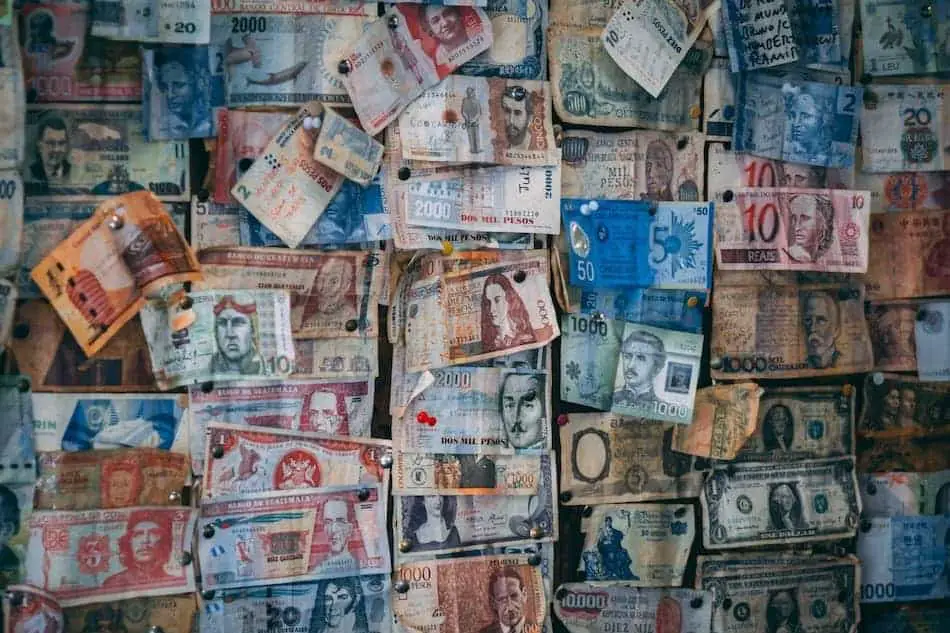
Have you ever wondered what the currencies of Spanish speaking countries are? I’m always curious to know what currencies I will need if I am traveling to a Spanish speaking country. So, I researched the currencies in Spanish speaking countries and wrote a helpful blog post.
What are the currencies of the Spanish speaking countries?
- Argentina – Peso
- Bolivia – Boliviano
- Chile – Peso
- Colombia – Peso
- Costa Rica – Colón
- Cuba – Peso
- Dominican Republic – Peso
- Ecuador – Dollar
- El Salvador – Dollar and Bitcoin
- Equatorial Guinea – Franc
- Guatemala – Quetzal
- Honduras – Lempira
- Mexico – Peso
- Nicaragua – Córdoba
- Panama – Balboa
- Paraguay – Guaraní
- Peru – Sol
- Puerto Rico – Dollar
- Spain – Euro
- Uruguay – Peso
- Venezuela – Bolívar
Many of these countries have evolved over time, so their currencies have changed with them. For example, the peso originally came from Spain, but as of 2002, Spain has moved to the Euro. We have more to discover about the currencies of the Spanish speaking countries. Plus, we dive into more Spanish related situations involving money.
Let’s go!
Currencies Of Spanish Speaking Countries
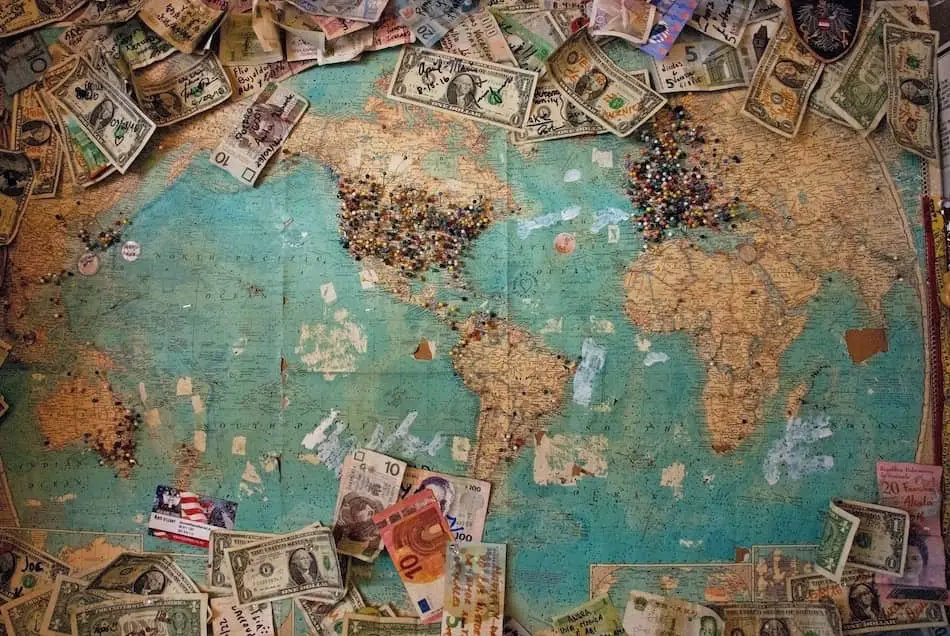
As stated above, the currencies of the Spanish speaking countries have changed over time. The peso originally came from Spain and was adopted by many Latin American countries during the Spanish Conquest of the Americas from the 17th century through the 19th century. Today, the peso still exists in some Latin American countries, but the peso is regulated by each individual country.
Let’s take a look at the currency of each Spanish speaking country.
Argentina: The unit of currency is the Argentine peso, which is divided into 100 centavos. The peso was introduced in 1992 to replace the Argentine austral due to the devaluation of the currency. The symbol of the peso is $.
Bolivia: The unit of currency in Bolivian is the boliviano, which is divided into 100 centavos. The first boliviano was introduced in 1864. In 1987, the first Bolivian peso was replaced by the current new boliviano due to the hyperinflation of the currency. The symbol of the currency is Bs.
Chile: The unit of currency is the Chilean peso, which is divided into 100 centavos. In 1975, the Chilean peso replaced the escudo. The symbol of the Chilean peso is Ch$.
Colombia: The unit of currency is the Colombian peso, which is divided into 100 centavos. The peso has been the currency of Colombia since 1810 when it replaced the real. The symbol of the currency is Col$.
Costa Rica: The unit of currency in Costa Rica is the colón, which is divided into 100 céntimos. In 1896, the colón was introduced to replace the Costa Rican peso. The colón was named after the Spanish explorer, Christopher Columbus, known as Cristóbal Colón in Spanish. The symbol of the colón is ₡.
Cuba: The unit of currency is the Cuban peso, which is divided into 100 centavos. The symbol of the currency is Cu$. Cuba has two official currencies, which are the Cuban Convertible Peso (CUC) and the Cuban Peso (CUP). The CUC is the currency most frequently used by tourists and the more valuable of the two. The CUC is tied to the U.S. Dollar so that 1 CUC equals 1 U.S. Dollar. The CUP is typically only used by Cuban residents.
Dominican Republic: The unit of currency is the Dominican peso, which is divided into 100 centavos. The first Dominican peso was introduced in 1844 to replace the Haitian gourde following the country’s independence from Haiti. The current Dominican peso, also known as the peso oro, was introduced in 1937. The symbol of the currency is RD$.
Ecuador: The unit of currency in Ecuador is the U.S. Dollar, which is referred to as a dólar and divided into 100 centavos. The U.S. Dollar became the official currency of Ecuador in the year 2000 when Ecuador’s own currency, the sucre, fell due to a financial crisis. The symbol for the U.S. Dollar is $.
El Salvador: The units of currency in El Salvador are the U.S. Dollar and Bitcoin. The U.S. Dollar is referred to as a dólar and divided into 100 centavos. The U.S. Dollar replaced the prior currency known as the colón. The symbol for the U.S. Dollar is $. As of September 2021, El Salvador is the first country in the world to adopt Bitcoin as its local currency.
Equatorial Guinea: The unit of currency in Equatorial Guinea of the Central African franc, which is divided into 100 céntimos. The Central African Franc replaced the Equatorial Guinea Ekwele in 1985. The Central African Franc is also the currency in Cameroon, Chad, Republic of Congo, Central African Republic, and Gabon. The symbol for the Centra African Franc is FCFA.
Guatemala: The unit of currency is the Guatemalan quetzal, which is divided into 100 centavos. The quetzal was introduced in 1925 and named after the national bird of Guatemala, the resplendent quetzal. The symbol of the currency is Q.
Honduras: The unit of currency is the Honduran lempira, which is divided into 100 centavos. The lempira was introduced in 1931 to replace the peso. Also, the lempira is named after the 16th-century ruler of the indigenous Lenca people, who fought against the Spanish conquistadors. The symbol for the currency is L.
Mexico: The unit of currency is the Mexican peso, which is divided into 100 centavos. Mexican coins are not very much in circulation because they have so little value. Mexican currency mostly uses pesos that are worth 1 or more. The symbol for the currency is Mex$.
Nicaragua: The unit of currency is the Nicaraguan córdoba, which is divided into 100 centavos. The córdoba replaced the peso and was introduced in 1912. It was named after the Conquistador Francisco Hernández de Córdoba, who is considered the founder of Nicaragua. The symbol for the currency is C$.
Panama: The unit of currency is the Panamanian balboa, which is divided into 100 centésimos. The balboa replaced the Colombian peso in 1904 following their independence. The balboa is pegged to the U.S. Dollar at 1-to-1, and the U.S. Dollar also legal tender in Panama. The symbol for the balboa is B/.
Paraguay: The unit of currency is the Paraguayan guaraní, which is divided into 100 céntimos. The currency is named after the Guaraní tribe, which was the indigenous people of Paraguay. The guaraní replaced the peso in 1943. The symbol for the currency is ₲.
Peru: The unit of currency is the Peruvian sol, which is divided into 100 céntimos. In 1991, the currency was introduced to replace the Peruvian inti and was originally called the nuevo sol. In 2015, the Peruvian Congress voted to name the currency simply sol. The symbol for the currency is S/.
Puerto Rico: The unit of currency of Puerto Rico is the U.S. Dollar, which is referred to as a dólar and divided into 100 centavos. Puerto Rico was ceded to the U.S. from Spain after the Spanish-American War of 1898. The U.S. Dollar replaced the prior currency known as the Puerto Rican Dollar after the monetary system of Puerto Rico was integrated with the U.S. The symbol for the U.S. Dollar is $.
Spain: The unit of currency of Spain is the euro, which is divided into 100 cents or céntimos. The euro is the money of the European Union and can be used throughout most of Europe. The euro was adopted by Spain in 2002 and replaced Spain’s prior currency known as the peseta. The symbol for the euro is €.
Uruguay: The unit of currency of Uruguay is the peso uruguayo, which is divided into 100 centésimos. In 1993, the peso uruguayo replaced the nuevo peso. The symbol for the currency is $U.
Venezuela: The unit of currency of Venezuela is the bolívar, which is divided into 100 céntimos. Technically, since 2018, the official currency is called the bolívar soberano (sovereign bolivar) that replaced the bolívar fuerte due to inflation. The symbols for the currency are either Bs.S or Bs.
Spanish Words and Phrases When Using Money
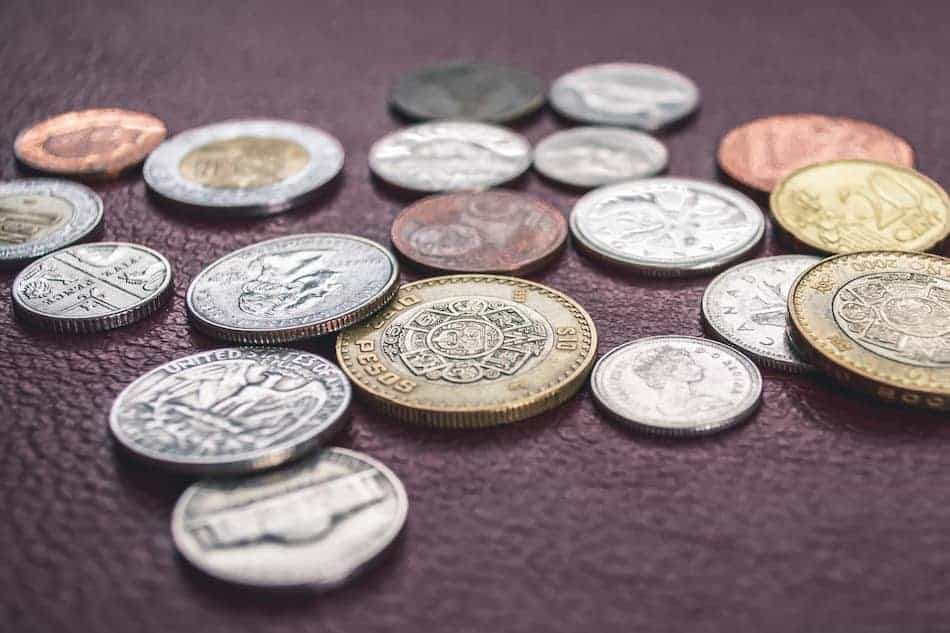
There is no use discussing the different currencies used in Spanish speaking countries if we don’t know how to discuss money in Spanish. So, we have tried to simplify things for you by introducing you to different Spanish words and phrases that are used when discussing money or currencies.
Below are some simple words that will introduce you to money, dollars, cents, etc. As you saw above, certain countries discuss cents
- Dinero – Money
- Dólar americano – Dollar (American Dollar)
- Dólar canadiense – Dollar (Canadian Dollar)
- Peso – the currency of Mexico and other Latin American countries
- Centavo – Cent
- Céntimo – Penny
- Centésimo – Hundredth or Cent for certain countries
- Moneda – Coin
- Billete – Bill
As you saw in the prior currency section, certain countries use either centavo, céntimo, or centésimo when discussing cents. Keep that in mind if you are traveling to different Spanish speaking countries.
There are some other words and phrases you may need when paying for something in Spanish. Below are some simple words and phrases that you may need when you are paying for something, taking out cash from the ATM, checking your bank accounts, or trying to pay your mortgage.
- Cambio – Change
- Tarjeta de crédito – Credit card
- Tarjeta de débito – Debit card
- Cajera automática – ATM
- Número secreto de pin – Secret pin number
- Cuenta de ahorros – Savings account
- Cuenta de cheques – Checking account
- Hipoteca – Mortgage
- Casa de Cambio – Exchange House
- Banco – Bank
Traveling and Exchange Rates of Currencies
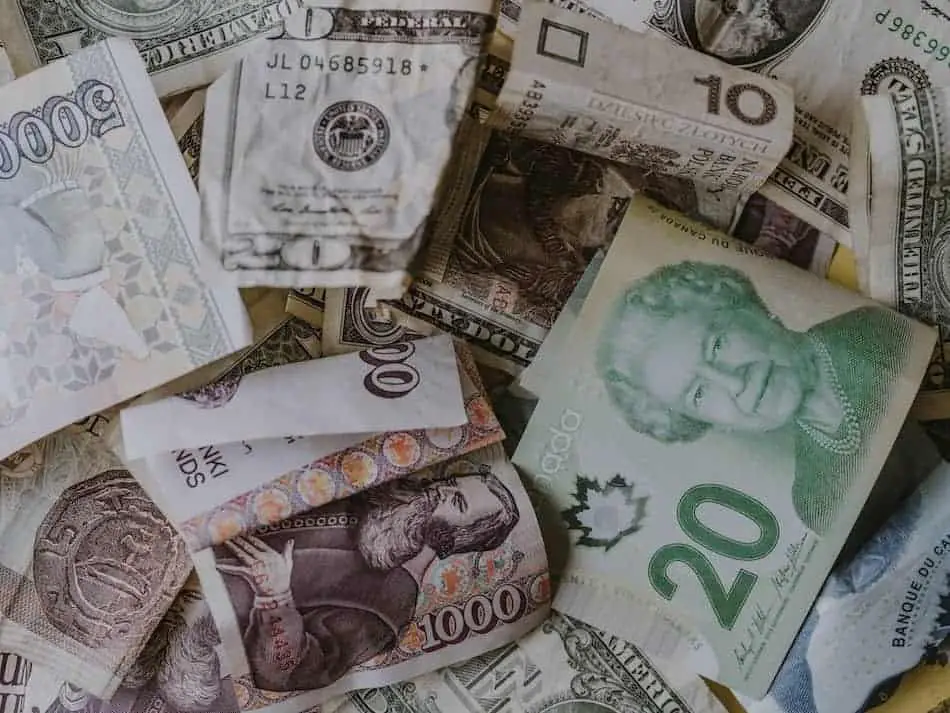
There are other places where we need to be prepared to have Spanish conversations revolving around money. A lot of those conversations may take place when we are preparing to travel to a Spanish speaking country or visiting a bank.
Let’s imagine that you are preparing to travel abroad and need to get some money from the banco (bank) or casa de cambio (money exchange). Here is how a Spanish conversation may take place when you are at the bank or money exchange.
- YOU: ¡Hola! ¿Cómo estás? – Hi! How are you?
- BANKER: ¡Hola! ¿Puedo ayudarte? – Hi! Can I help you?
- YOU: Quisiera cambiar dólares por pesos. – I would like to change dollars for pesos.
- BANKER: Sí claro. Por favor, dame los dólares que quieres cambiar. – Yes, of course. Please give me the dollars you want to exchange.
- YOU: Aquí tienes. – Here you go.
- YOU: ¿Me puede dar billetes de cincuenta? – Can you give me bills of fifty (50)?
- BANKER: Sí claro. Aquí tienes. – Yes, of course. Here you go.
- YOU: Gracias. Que tengas un buen día. – Thank you. Have a nice day.
Here is a second example of how this conversation may take place at a bank or money exchange.
- YOU: ¡Hola! ¡Buenos días! – Hi! Good morning!
- BANKER: ¡Hola! ¿Cómo puedo ayudarte hoy? – Hi! How can I help you today?
- YOU: Tengo que cambiar dólares por pesos. – I have to change dollars for pesos.
- BANKER: No hay problema. Dame el dinero, por favor. – No problem. Give me the money, please.
- YOU: Aquí tienes. – Here you go.
- YOU: ¿Me puede dar billetes de bajo importe? – Can you give me small bills?
- BANKER: Si, aqui tienes. – Yes, here you go.
- BANKER: ¿Necesitas algo más? – Do you need anything else?
- YOU: No, gracias. – No, thank you.
- BANKER: De nada. – You’re welcome.
Exchange Rates of Currencies of Spanish Speaking Countries
Another fun thing we can do is check on the exchange rate for different currencies. Below I have listed the exchange rates for the currencies in each Spanish speaking country as of January 2020, and have compared them to the U.S. Dollar and the Euro.
Exchange Rate for Currencies of Spanish Speaking Countries Against $1.00 U.S. Dollar:
| Country | Currency | 1 U.S. Dollar |
| Argentina | 60.01 Argentine Pesos | $1.00 |
| Bolivia | 6.92 Bolivian Bolivianos | $1.00 |
| Chile | 777.10 Chilean Pesos | $1.00 |
| Colombia | 3,366.00 Colombian Pesos | $1.00 |
| Costa Rica | 565.62 Costa Rican Colóns | $1.00 |
| Cuba | 1.00 Cuban Pesos | $1.00 |
| Dominican Republic | 53.46 Dominican Pesos | $1.00 |
| Ecuador | $1.00 U.S. Dollar | $1.00 |
| El Salvador | $1.00 U.S. Dollar | $1.00 |
| Equatorial Guinea | 9,414.99 Guinean Francs | $1.00 |
| Guatemala | 7.69 Guatemalan Quetzals | $1.00 |
| Honduras | 24.81 Honduran Lempiras | $1.00 |
| Mexico | 18.79 Mexican Pesos | $1.00 |
| Nicaragua | 34.22 Nicaraguan Córdobas | $1.00 |
| Panama | 1.00 Panamanian Balboa | $1.00 |
| Paraguay | 6,521.80 Paraguayan Guaranis | $1.00 |
| Peru | 3.32 Sol | $1.00 |
| Puerto Rico | $1.00 U.S. Dollar | $1.00 |
| Spain | 0.91 Euro | $1.00 |
| Uruguay | 37.34 Uruguayan Pesos | $1.00 |
| Venezuela | 248,487.87 Venezuelan Bolivar | $1.00 |
Exchange Rate for Currencies of Spanish Speaking Countries Against €1.00 Euro:
| Country | Currency | €1.00 Euro |
| Argentina | 66.17 Argentine Pesos | €1.00 |
| Bolivia | 7.63 Bolivian Bolivianos | €1.00 |
| Chile | 857.03 Chilean Pesos | €1.00 |
| Colombia | 3,711.25 Colombian Pesos | €1.00 |
| Costa Rica | 623.63 Costa Rican Colóns | €1.00 |
| Cuba | 1.10 Cuban Pesos | €1.00 |
| Dominican Republic | 58.95 Dominican Pesos | €1.00 |
| Ecuador | $1.10 U.S. Dollars | €1.00 |
| El Salvador | $1.10 U.S. Dollars | €1.00 |
| Equatorial Guinea | 10,380.27 Guinean Francs | €1.00 |
| Guatemala | 8.48 Guatemalan Quetzals | €1.00 |
| Honduras | 27.35 Honduran Lempiras | €1.00 |
| Mexico | 20.71 Mexican Pesos | €1.00 |
| Nicaragua | 37.73 Nicaraguan Córdobas | €1.00 |
| Panama | 1.10 Panamanian Balboas | €1.00 |
| Paraguay | 7,190.35 Paraguayan Guaranis | €1.00 |
| Peru | 3.66 Sol | €1.00 |
| Puerto Rico | $1.10 U.S. Dollars | €1.00 |
| Spain | €1.00 Euro | €1.00 |
| Uruguay | 41.17 Uruguayan Pesos | €1.00 |
| Venezuela | 274,650.05 Venezuelan Bolivar | €1.00 |
Shopping in Spanish
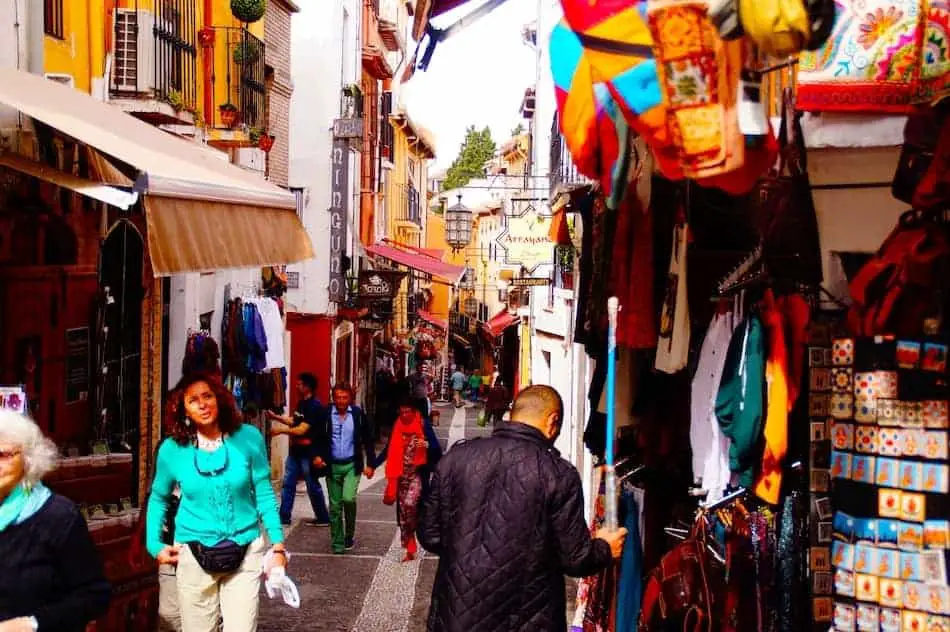
When we think about using our money in Spanish settings, one of the first things we can use it for is to shop. Whether you are in a market or at a restaurant, these are common places where money is discussed.
Below are some common words and phrases you may see or use when shopping.
- ¿Cuánto cuesta? – How much?
- ¿Cuánto cuesta eso? – How much does that cost?
- Me gusta ______ – I like _______
- No me gusta – I don’t like _________
- Es caro. – It is expensive
- Es barato. – It is cheap.
- ¿Qué tal esto? – How about this?
- Lo compro. – I buy it.
- Precio final. – Final price.
- Descuento. – Discount.
- Promoción. – Sale.
When we think about shopping in Spanish, it can be a good idea to walk through a typical conversation you might have when you are at the store or market. Here is how a conversation may go in Spanish while you are out shopping for clothes at the mall or market.
- YOU: ¡Hola! Buenas tardes. – Hi! Good afternoon.
- EMPLOYEE: ¡Hola! Bienvenido a mi tienda. – Hi! Welcome to my store.
- YOU: ¿Cuánto cuesta el vestido? ¡Me gusta! – How much does the dress cost? I like it.
- EMPLOYEE: Veinticinco dólares. – Twenty-five dollars.
- YOU: Es caro. – It is expensive
- YOU: ¿Cuánto cuesta eso? – How much does that cost?
- EMPLOYEE: Cinco dólares. – Five dollars.
- YOU: Es barato. – It is cheap.
- YOU: ¿Cuánto cuestan esos? – How much are those?
- EMPLOYEE: Diez dólares. – Ten dollars.
- EMPLOYEE: ¿Vas a comprar algo? – Are you going to buy anything.
- YOU: No lo creo. – I don’t think so.
- EMPLOYEE: ¡Dios mío! – Oh my God!
Related Questions
Which European Union countries use the euro? Not all European Union countries use the euro. The following 19 European Union countries use the euro as currency: Austria, Belgium, Cyprus, Estonia, Finland, France, Germany, Greece, Ireland, Italy, Latvia, Lithuania, Luxembourg, Malta, the Netherlands, Portugal, Slovakia, Slovenia, and Spain.
Do all Latin American countries use pesos? No, not all Latin American countries use the peso. The countries that use the peso in Latin America are Argentina, Chile, Colombia, Cuba, the Dominican Republic, Mexico, and Uruguay. The Philippines also uses the peso, but it is located in Asia. However, each country has its own peso.
What is the most popular currency in the world? The U.S. Dollar is the most popular currency in the world. It is considered the de facto global currency held by central banks as a foreign reserve currency. The next most popular currencies are the Euro, the Japanese Yen, the Great British Pound, the Australian Dollar, and the Canadian Dollar.
